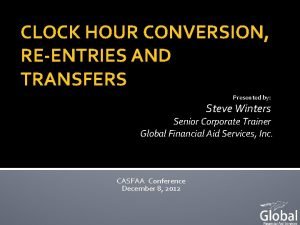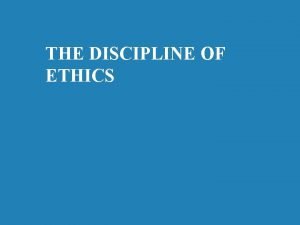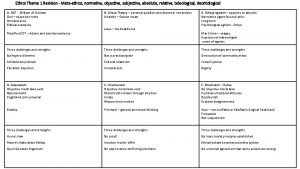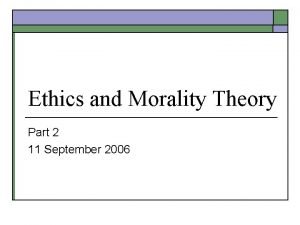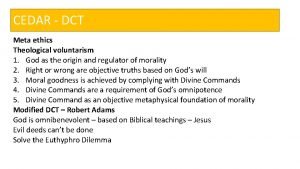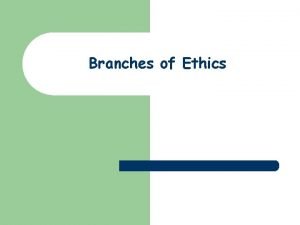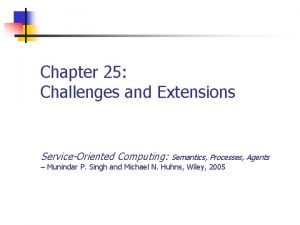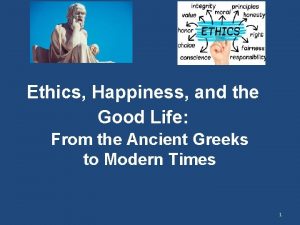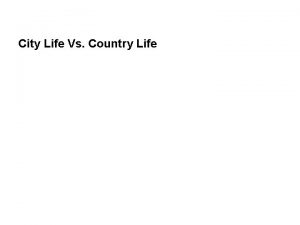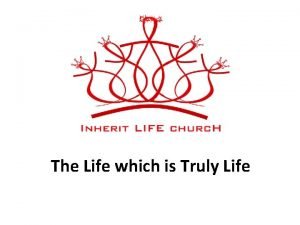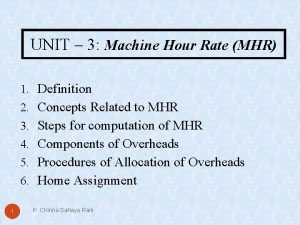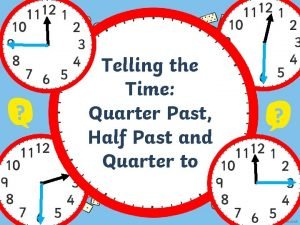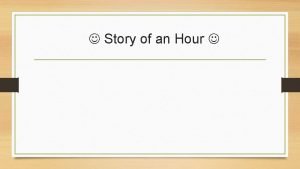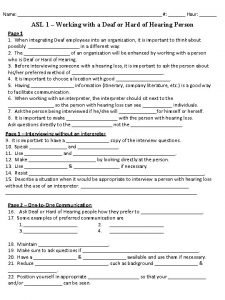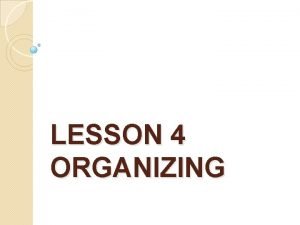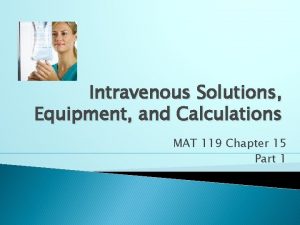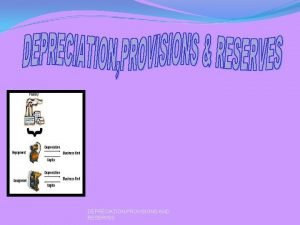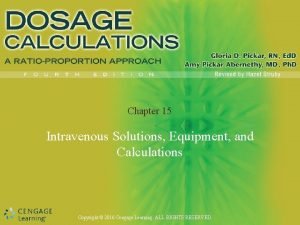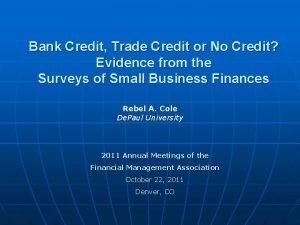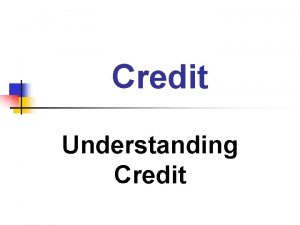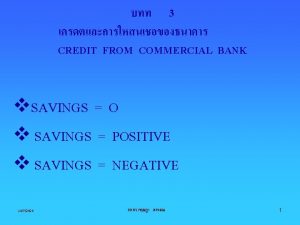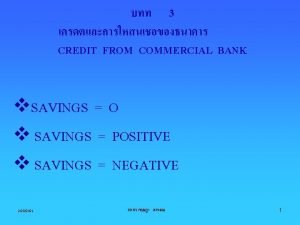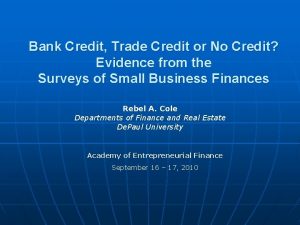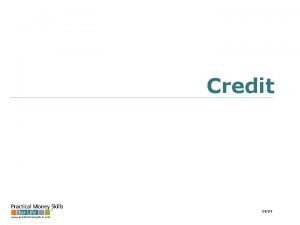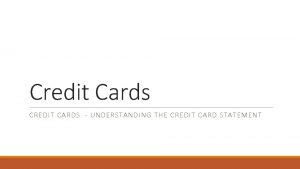Ethics In Life 1 hour Ethics Credit KS














































































- Slides: 78

Ethics In Life 1 hour Ethics Credit KS & MO C. E. Solutions Tracy Young, CLU, HIA, ALHC 913 -980 -CE 4 U(2348) www. continuingedsolutions. com

Ethics In Life 2 • Review and study this course at your leisure. • Once the course is completed, enter the exam through the Class. Marker link at the end of the exam. • You must receive a score of 70% or better to pass. • You may retake the test at no additional cost as needed. • The Kansas Insurance Department requires that all exams be taken in the presence of an approved disinterested 3 rd party monitor (Missouri no longer has this requirement). • Course Certificate will be emailed and sent electronically to the insurance department when notification of a passing score and, if required, an affidavit signed by the person monitoring the test is received.

C. E. Solutions 3 The material presented in this course is for educational and informational purposes only. It should not be used to provide guidance to your customers or clients in lieu of competent, certified, legal advice. The parties involved in the development of this course shall not be liable for any inappropriate use of this information beyond the purpose stated above. As a student, you should understand that it is your responsibility to adhere to the laws and regulations pertaining to any aspect of this course and the materials presented within.

Ethics In Life • Course Description: This course will cover ethical issues involving Life insurance … including ethical illustrations, the ethics of rebating and replacing, and consumer expectations. We will also compare the different independent rating companies and determine how they can help you decide which company to work for or place your business with. 4

A Quote From Mark Twain. . 5 “A lie can travel halfway around the world while the truth is putting on its shoes. ”

Selling Life Insurance • In the “good old days”, selling life insurance was basically a simple process. • You needed a rate book … • Most of the rate books were small enough to fit in a shirt pocket! • You had fewer products to market. • You were more likely to go to the customer’s home, or their business to conduct business. 6

What Revolutionized the Selling of Life Insurance? • The electronic revolution. • Do you remember the introduction of the “Super computers”? • The “Home Office” had them. • If you had a special client … or a really big life policy … you could send your request for a detailed illustration. • It could be a two-week process, considering mail and processing time, to have an illustration to present to your client. 7 This Photo by Unknown Author is licensed under CC BY-ND

What Revolutionized the Selling of Life Insurance? • Then came … desktop computers: • Your own computer! • The ability to print your own illustrations! • Now we have laptops that carry more power than that home office computer had at its disposal only ten years ago. 8

Technology and Life Insurance 9 • It’s an interesting combination – a coldly logical tool like a computer, injected into a sales interview situation requiring sensitivity, warmth, & often emotion rather than logic. How do you make it work? he t g the n i at so see ” u it tor an g. S n “ ni c i p mo ured ty m ins t I’ a h w “W an e ta ou ke tli no i co t in ne te m to & t s o p th ut th yp n er e e e i le nsu aft av es red er. ”

What products were developed and are enhanced because of the computer? • Flexible products like Universal Life. • Variable Life Insurance. • More comprehensive illustrations. What do you do to help your customer better understand? 10

Consumer Understanding 11 • The flexibility of modern life insurance products is a tremendous benefit for the consumer. With technology, we are able to better customize illustrations to fit our customers needs. • Are there disadvantages to the flexible products & complex illustrations? • Consumers may find it difficult to understand. • Sometimes too much information may lead to indecision … and a missed sale. • There is an increased potential for abuse.

Consumer Understanding 12 • Think of how many hours you have spent studying, training, testing (not to mention continuing education) to learn life insurance? ! • What do you do to help a prospective insured understand pages of computerized illustrations, plus the details and differences of life policies in a 1 -2 hour interview?

Consumer Understanding • Offer company-approved brochures that summarize products discussed. • This gives the customer something they can take home with them to review. • It provides a guideline for the agent’s discussion, with less likelihood of leaving out something important. • Understand it may take several meetings with a customer before the life needs are determined and a sale is made. 13

What Do Today’s Customers Want? • They may need more information. • Some will come to you with quotes and information they have researched on the internet. They may have questions as to how they compare. • They will expect truthfulness. • They want to know the product they buy is what you say it is. • And some are willing to pay lawyers to get it. 14

What Can Go Wrong? • Dishonest agents have created illustrations using unrealistic assumptions about interest rates, mortality costs & expenses and lead insurance prospects to purchase policies. • The prospect is overwhelmed by all the numbers on the page, and the unethical agent draws attention to the one or two “really important numbers” … finding the column with the highest interest assumption & the lowest mortality & expense assumptions. 15

What Can Go Wrong? 16 • When the policy does not perform as expected, the prospect is disillusioned and disgusted with life insurance. • When the ethical agent approaches this customer, they have additional work to do. • The agent has to regain this person’s trust in the life insurance product.

What is the challenge to you … the ethical agent? • Finding a way to explain a difficult-to -understand product with a complicated illustration … in a way that genuinely helps prospects make good decisions. 17

How do you do that? • The agent helps the prospect understand the “big picture” of how life insurance moves the prospect toward his financial goals. • Use the illustration to help define important details about how the product works. • Reveal any risks that are involved. 18

Can a life insurance company share responsibility for improper illustrations? 19 YES! • Life insurance illustration software is created by or for the insurer. In order to give the agent the power to create inaccurate illustrations, the software has to be designed with that capability in place. • An agent would be hard-pressed to manipulate illustration software beyond what’s allowed by the software design. • You may have seen some changes over the years, in the flexibility of your illustrations. Most programs allow for very little, if any, manipulations any more.

The NAIC Illustration 20 • Part of the fallout of the market conduct scandals in recent years is the increased effort by the National Association of Insurance Commissioners (NAIC) to curb abuse of policy illustrations.

What did the NAIC do in 1995 that changed life illustrations? 21 • After a highly publicized case of illustration abuse in Florida, the NAIC stepped in with some new rules. • They formed a committee that developed “standards” for policy illustrations. • They mandated how the illustration must be calculated & what assumptions are permitted.

What Are Some Of The NAIC Illustration Requirements? • The illustration must be signed by the prospect & the agent. • The illustration must match exactly the insurance applied for. • Any revised illustration must also be signed & dated. 22 • Companies that use illustrations must identify one or more actuaries who will certify the illustration’s reasonableness. • Mortality projections must be based on company experience (or industry experience). • Mortality cannot be projected to improve over the period illustrated.

What Are The benefits to the NAIC Life Insurance Illustrations Model Regulation? • The illustrations are more credible. • There is more consistency between illustrations. • You can now compare apples to apples. • There is more disclosure to the consumer. 23

Is There A Downside To The NAIC Life Insurance Illustrations Model Regulation? 24 • There are more pages, more text & more numbers. • The illustrations are more complex. • The illustration is more difficult for an average person to understand.

Isn’t This Carrying It To The Extreme? 25 • Why are agents and prospects put through this rigorous challenge just to look at a life illustration? • Because unscrupulous agents & companies insisted on playing games with illustrations.

Organizations That Help What channels are available to help combat market conduct problems and rebuild the public’s trust? • National Association of Insurance & Financial Advisors • Society of Financial Service Professionals • American Council of Life Insurers • Insurance Marketplace Standards Association (IMSA) 26

National Association of Insurance & Financial Advisors • Their website, www. naifa. org, gives information regarding government relations and consumer information. • They provide consumers information regarding: • Life, health, disability, & long term care insurance. • Stocks, bonds, mutual funds, & 401 K plans. • Managing your retirement & estate … asset allocation, annuities, living will, durable power of attorney, gifting, bypass and irrevocable life insurance trusts. 27

Society of Financial Service Professionals • By going to www. financialpro. org, consumers can find the following information: • General financial planning topics. • Tax law information for estate planning, pension, and profit sharing. • Tips on choosing a financial advisor. • Tips on purchasing life insurance, disability insurance & utilizing charitable gifts. 28

Society of Financial Service Professionals 29 • The Code of Professional Responsibility of the Society of Financial Service Professionals is divided into five components, as follows: • Preamble – a brief introduction to the Code of Professional Responsibility, including its history and purpose. • Canons – inspirational model standards of exemplary professional conduct. • Rules – specific standards of a mandatory and enforceable nature. • Applications – practical examples of how the canons and rules apply in given situations. • Disciplinary Procedures – the mechanisms for enforcement of the Code of Professional Responsibility. • They even have a confidential ethics hotline that consumers and professionals may call to report unethical behavior.

American Council of Life Insurers u At www. acli. com, consumers will find tips for returning income from tax returns to their retirement savings, and how to purchase life, disability, long term care, and annuities. – Also on the website, you can find information regarding hot political issues facing congress and locally in our states. 30

The Ethics of Rebating — returning a portion of the premium or the agent's/broker's commission on the premium to the insured or other inducements to place business with a specific insurer. Rebating is illegal in the majority of states. Insurers must use filed rate credits or have supporting methodology. 31

Rebating and Replacement 32 In insurance, “rebating” is not allowed, and “replacement” is not always ethical. • What is rebating? • Returning part of a premium to the insurance applicant as a rebate. • What is replacement? • Replacing existing life insurance.

Debating Rebating 33 What’s wrong with rebating? Automobile Companies do it all the time! • From Yahoo! Finance, “The Effects Of Lapsing Your Life Insurance Policy”” insurance. yahoo. com/lh/policylapse. in. html “Watch Out for Rebating … If an agent approaches you about giving you a chunk of his commission … if you agree to lapse your policy and apply for a new one, watch out. That's a practice called "rebating" and it's illegal in all states except for Florida and California, according to Jack Dolan, a spokesperson for the American Council of Life Insurers. Rebating applies to any sales practice in which an agent entices a customer to buy an insurance product by giving him or her part of the commission. ”

Debating Rebating • From Yahoo! Finance, “The Effects Of Lapsing Your Life Insurance Policy”” insurance. yahoo. com/lh/policylapse. in. html “Rick Sabo of Money Concepts International in Gibsonia, Penn. , a former agent with Metropolitan Life Insurance Co. who is now a consultant to policyholders and attorneys in insurance lawsuits, says that rebating is extremely rare. And even if agents convince a person to lapse an old policy, the customer may not realize what they are doing…” 34

Debating Rebating • From Yahoo! Finance, an article shares this info … “Watch Out for Rebating” insurance. yahoo. com/lh/policylapse. in. html “Randy Mc. Connell, a spokesperson for the Missouri Department of Insurance also says that rebating is much rarer than other forms of insurance fraud, such as churning. He says that if an agent wants to illegally mishandle a policy, they have greater incentive to do it on their own rather than team up with the insured because they will not have to split the commission. Rebating ‘is not a high volume kind of thing’…” 35

Debating Rebating • From Yahoo! Finance, an article shares this info … “Watch Out for Rebating” insurance. yahoo. com/lh/policylapse. in. html “Lisa Santucci, a senior attorney with the Florida Department of Insurance, receives a number of inquiries from agents and insurance companies asking if they can give a cash bonus to a customer who buys a policy or annuity from them. But she has not seen any cases where an agent and a customer "teamed up" to churn a policy and split the commission on the new policy. ” 36

Debating Rebating 37 • From The Office of General Counsel of the New York State Insurance Department … “According to the express language of the statute, insurance agents and brokers are prohibited from offering rebates or other inducements in connection with the sale of life insurance, health insurance or annuities, when such rebates or inducements are not specified in the policy or contract of insurance. The purpose of the statute is to prohibit agents and brokers from offering a contract other than what is expressly stated in the policy. Therefore, if it is not in the contract, it cannot be used as an inducement to purchase the policy. ” www. ins. state. ny. us/rg 003101. htm

Debating Rebating 38 • From the Florida Association of Insurance Agents www. faia. com/education/edlibrary/fees. cfm 626. 572 Rebating; when allowed. -- • (1) No agent shall rebate any portion of his or her commission except as follows: • (a) The rebate shall be available to all insureds in the same actuarial class. • (b) The rebate shall be in accordance with a rebating schedule filed by the agent with the insurer issuing the policy to which the rebate applies. • (c) The rebating schedule shall be uniformly applied in that all insureds that purchase the same policy through the agent for the same amount of insurance receive the same percentage rebate. • (d) Rebates shall not be given to an insured with respect to a policy purchased from an insurer that prohibits agents from rebating commissions.

Debating Rebating 39 • From the Florida Association of Insurance Agents www. faia. com/education/edlibrary/fees. cfm 626. 572 Rebating; when allowed. - • (e) The rebate schedule is prominently displayed in public view in the agent's place of doing business and a copy is available to insureds on request at no charge. • (f) The age, sex, place of residence, race, nationality, ethnic origin, marital status, or occupation of the insured or location of the risk is not utilized in determining the percentage of the rebate or whether a rebate is available. • (2) The agent shall maintain a copy of all rebate schedules for the most recent 5 years and their effective dates. • (3) No rebate shall be withheld or limited in amount based on factors, which are unfairly discriminatory. • (4) No rebate shall be given which is not reflected on the rebate schedule. • (5) No rebate shall be refused or granted based upon the purchase or failure of the insured or applicant to purchase collateral business.

What problems does rebating premiums cause? 40 • Applicant could simply contract a new agent every year & drive a bargain for a new policy & new rebate. • Price was often the only criteria for purchasing a policy. • Adversely affected the pricing of insurance products because of the resulting lapse ratios. • Some companies designed policies with large first year premiums to allow for the rebate (Pity the poor consumer who didn’t know he could bargain for the premium amount and paid full price). • Uninformed insurance consumers were subsidizing the rebating craze. • Agents commission was not guaranteed.

The Ethics of Rebating • Is rebating part of the cost of a product to a consumer unethical? Car companies & many other retailers do it all the time – and customers love it! • But in insurance it is illegal and should be avoided at all times & places regardless. Doing so has proven to deliver poor results for agents, companies & consumers. 41

What About Replacement? What are the potential losses to the insured with a replacement? Is a replacement of an existing policy always bad for the policyholder? 42 What do replacement regulations focus on? Disclosure!

What About Replacement? • Before 1906, there was no statutory requirement of guaranteed cash value, no requirement to pay dividends annually & no incontestability clause. • Replacement of a policy then did not hold as many concerns as it is does today. 43

What are the potential losses to the insured with a replacement? 44 • If death occurs during the contestable period, the claim may not be paid. • In Kansas, “prior time served” is carried over to the new policy for the contestable period. • If suicide occurs within the suicide exclusion period. • Expenses associated with issuing new life policy (front loaded). • Loses the benefit of cash value build-up & dividends.

How does replacement work against 45 the agent & company? • Widespread replacement costs everyone. • A company will not realize the anticipated persistency it calculated into premium rates at time of issue. • An agent loses a life client & possibly other lines of business with that client.

Replacement 46 • What is another term for replacement? • “Twisting” • Is a replacement of an existing policy always bad for the policyholder? • No. The policyholder may be able to purchase a better policy at the same or lower cost depending on what type of policy they own.

Kansas Replacement Notice • When you do replace a policy, the customer must be given a notice such as this. 47

The Ethics of Replacement 48 • The fact that replacement is not illegal places it squarely in the realm of ethical behavior.

Before you Replace a Life Policy… consider: • The “Golden Rule”. • Would you make this replacement for yourself if you were both policyholder and agent? • If you replace a contract tonight, and all the facts of the transaction are published in tomorrow’s newspaper for all your friends, relatives, clients & competitors to see … • will they condone your actions? 49

50 • Rebating is illegal in Kansas and Missouri, though not technically unethical. • Replacement is potentially unethical, but not illegal. • Follow this rule: Never engage in rebating & replace existing coverage only when it’s in the best interest of the insured. By keeping this rule, you will never be faced with the third “R” of market conduct … REGRET!

Choosing a Company 51 • How do you choose a company to represent? • If you are a captive agent for only one company, you may have chose that company for it’s reputation in the business. • For some, it may just have been the employment opportunity that came at the “right time”.

Choosing a Company 52 • What does the Independent insurance agent look at when they decide what Life Insurance Companies to represent? • • Company reputation? Quality of service provided to customers? Details of the agent’s contract? All of the above?

Choosing a Company 53 • Choosing a life insurance company to represent isn’t always a well-informed decision. • Did you know the details of your company policies or conduct when you entered the life insurance business?

Company Philosophy Towards Policyholders 54 • Most companies treat both their policyholders & their agents very well; working hard to fulfill the promise made to the individual at the time the policy was issued.

When Does The Life Company Fulfill Their Promise? • Upon the death of their insured. • Death claims are generally easy & quick to administer. • Seldom is there cause for dispute. • Paperwork is usually a claim form, death certificate & or a newspaper obituary. • The claim check is sometimes even more than expected due to interest or dividends. 55

Fulfilling The Promise • From an ethics & market conduct perspective, efficient claim settlement is very important. • There should be no hassles at a time when a loved one has just been lost. • The payment should be made without delay. 56

Other Interested Parties • Stockholders – interests are generally centered around the return on their investment & they require (& are entitled to) fair return on the capital they have invested. Stockholders do have the power to control &/or change company management, so the company usually takes care to treat this group fairly. • Mutual Company policyholders – Policyholders play virtually no role in company operations & have very little, if any, control over the board of directors. This group has little or no knowledge of the business. Unethical companies may take advantage of this. 57

How Do You Know How a Mutual Company Treats Its Policyholder/Owners? • Listen carefully & be observant. • Senior management may refer to the policyholders as “owners”. • There is references in policyholder communications to “your company” or “your board of directors”. • Comments by managers such as “This is not a good use of our policyholder’s money”. • You will want to know the company you represent is responsible toward your policyholders. 58

The Golden Rule • The Golden Rule applies again. • Place your client’s insurance business with companies that you would choose for your own insurance needs. 59

Company Philosophy Toward Its Agents 60 • Choose a company whose employees (underwriters, claims people, management, etc. ) treat agents as they would want to be treated themselves. • The home office employees should treat agents as full partners in fulfilling the company’s mission. • When should you be concerned? • When there is generally a poor attitude of home office employees toward agents. • When there is a lack of respect for the agent’s paycheck (timing of policy issuance or commission delays).

Industry Ratings 61 • What are the company’s ratings? Placing your client’s life insurance protection in the hands of a company you know to be financially weak is not only unethical, you could be held liable.

What Are Sources For Independent Ratings of a Company’s Financial Strength? • A. M. Best Company. • www. ambest. com • Standard & Poor’s Insurance Rating Services. • www. standardandpoors. com • Moody’s Investment Service. • www. moodys. com • Fitch Ratings • www. fitchratings. com • Weiss Ratings. • www. weissratings. com 62

A. M. Best 63 A. M. Best assigns two types of ratings. Both are independent opinions, based on a comprehensive quantitative and qualitative evaluation, of a company's balance sheet strength, operating performance and business profile. They are not a warranty of a company's financial strength and ability to meet either its obligations to policyholders or its financial obligations.

A. M. Best 64 Financial Strength Ratings A Best's Financial Strength Rating (FSR) is an opinion of an insurer's ability to meet its obligations to policyholders. Rating Modifiers and Affiliation Codes may also be associated with these ratings. The following list outlines our rating scale and associated descriptions. SECURE VULNERABLE A++, A+ (Superior) B, B- (Fair) A, A- (Excellent) C++, C+ (Marginal) B++, B+(Very Good) C, C- (Weak) D (Poor) E (Under Regulatory Supervision) F (In Liquidation) S (Rating Suspended)

Debt Ratings A. M. Best 65 A. M. Best's Long-Term Debt Rating (issue credit rating) is an opinion as to the issuer's ability to meet its financial obligations to security holders when due. These ratings are assigned to debt and preferred stock issues. Ratings from "aa" to "ccc" may be enhanced with a "+" (plus) or "-" (minus) to indicate whether credit quality is near the top or bottom of a category. A company's Long-Term Credit Rating also may be assigned an Under Review modifier ("u") that generally is event-driven (positive, negative or developing) and indicates that the company's Best's Rating opinion is under review and may be subject to near-term change. Long-Term Credit Ratings Investment Grade Non-Investment Grade aaa (Exceptional) bb (Speculative) aa (Very Strong) b (Very Speculative) a (Strong) ccc, c (Extremely Speculative) bbb (Adequate) d (In Default)

Standard and Poor’s 66 • INSURER FINANCIAL ENHANCEMENT RATING DEFINITIONS • A Standard & Poor's Insurer Financial Enhancement Rating is a current opinion of the creditworthiness of an insurer with respect to insurance policies or other financial obligations that are predominantly used as credit enhancement and/or financial guarantees. When assigning an Insurer Financial Enhancement Rating, Standard & Poor's analysis focuses on capital, liquidity, and company commitment necessary to support a credit enhancement or financial guaranty business. • Insurer Financial Enhancement Ratings are based, in varying degrees, on all of the following considerations: • Likelihood of payment-capacity and willingness of the insurer to meet its financial commitment on an obligation in accordance with the terms of the obligation; • Nature of and provisions of the obligations; and • Protection afforded by, and relative position of, the obligation in the event of bankruptcy, reorganization, or other arrangement under the laws of bankruptcy and other laws affecting creditors' rights.

Standard and Poor’s Insurer Financial Enhancement Ratings • AAA EXTREMELY STRONG capacity to meet its financial commitments. ‘AAA’ is the highest Insurer Financial Enhancement Rating assigned by Standard & Poor’s. • AA VERY STRONG capacity to meet its financial commitments. It differs from the highest-rated insurers only in small degree. • A STRONG capacity to meet its financial commitments but is somewhat more susceptible to the adverse effects of changes in circumstances and economic conditions than higher-rated insurers. • BBB ADEQUATE capacity to meet its financial commitments. However, adverse economic conditions or changing circumstances are more likely to lead to a weakened capacity of the insurer to meet its financial commitments. 67 • BB LESS VULNERABLE in the near term than other lower-rated insurers. However, it faces major ongoing uncertainties and exposure to adverse business, financial, or economic conditions that could lead to the insurer's inadequate capacity to meet its financial commitments. • B MORE VULNERABLE than the insurers rated 'BB', but the insurer currently has the capacity to meet its financial commitments. Adverse business, financial, or economic conditions will likely impair the insurer's capacity or willingness to meet its financial commitments. • CCC CURRENTLY VULNERABLE, and is dependent upon favorable business, financial, and economic conditions to meet its financial commitments. • CC CURRENTLY HIGHLY VULNERABLE. • Plus (+) or minus (-): Ratings may be modified by the addition of a plus or minus sign to show relative standing within the major rating categories.

Moody’s 68 Insurance Financial Strength Ratings • Moody’s Insurance Financial Strength Ratings are opinions of the ability of insurance companies to repay punctually senior policyholder claims and obligations. Long-Term Insurance Financial Strength Ratings • Moody’s rating symbols for Insurance Financial Strength Ratings are identical to those used to indicate the credit quality of long-term obligations. These rating gradations provide investors with a system for measuring an insurance company’s ability to meet its senior policyholder claims and obligations.

Moody’s 69 • Aaa … offer exceptional financial security. While the credit profile of these companies is likely to change, such changes as can be • B … offer poor financial security. Assurance visualized are most unlikely to impair their of punctual payment of policyholder fundamentally strong position. obligations over any long period of time is small. • Aa … offer excellent financial security. They are rated lower because long-term risks • Caa … offer very poor financial security. appear somewhat larger. They may be in default on their policyholder obligations or there may be present elements • A Insurance companies rated A offer good of danger with respect to punctual payment financial security. However, elements may be of policyholder obligations and claims. present which suggest a susceptibility to impairment sometime in the future. • Ca … offer extremely poor financial security. Such companies are often in default on their • Baa … offer adequate financial security. policyholder obligations or have other However, certain protective elements may be marked shortcomings. lacking or may be characteristically unreliable over any great length of time. • C … are the lowest-rated class of insurance company and can be regarded as having • Ba … offer questionable financial security. extremely poor prospects of ever offering Often the ability of these companies to meet financial security. policyholder obligations may be very moderate and thereby not well safeguarded in the future.

Fitch The Fitch Ratings Insurance Group provides ratings and research on insurance and insurance-related companies worldwide. Because of the increasing globalization of insurance markets, the group coordinates all research and analysis through a Global Insurance Ratings & Policy Committee, whose goal is to achieve consistency of rating methodology across countries. At the same time, Fitch strives to ensure that its insurance ratings fully incorporate the unique aspects of local markets by assigning lead analysts with local market knowledge and presence. The Insurance Group balances local expertise with global oversight to distinguish their ratings in the marketplace. 70

Fitch • AAA Exceptionally Strong. . . viewed as possessing exceptionally strong capacity to meet policyholder and contract obligations. For such companies, risk factors are minimal and the impact of any adverse business and economic factors is expected to be extremely small. 71 • B Weak. . . viewed as weak with a poor capacity to meet policyholder and contract obligations. Risk factors are very high, and the impact of any adverse business and economic factors is expected to be very significant. • CCC. C Very Weak. . . viewed as very weak with a • AA Very Strong. . . viewed as possessing very strong very poor capacity to meet policyholder and contract obligations. Risk factors are extremely Risk factors are modest, and the impact of any high, and the impact of any adverse business and economic factors is expected to be insurmountable. be very small. A ‘CC’ rating indicates that some form of insolvency or liquidity impairment appears probable. A ‘C’ • A Strong … viewed as possessing strong capacity to rating signals that insolvency or a liquidity meet policyholder and contract obligations. Risk impairment appears imminent. factors are moderate, and the impact of any adverse business and economic factors is expected to be small. • DDD, D Distressed. . . These ratings are assigned to companies that have either failed to make • BBB Good. . . viewed as possessing good capacity to payments on their obligations in a timely manner, meet policyholder and contract obligations. Risk are deemed to be insolvent, or have been subjected factors are somewhat high, and the impact of any to some form of regulatory intervention. Within the adverse business and economic factors is expected to ‘DDD’–‘D’ range, those companies rated ‘DDD’ have be material, yet manageable. the highest prospects for resumption of business operations or, if liquidated or wound down, of • BB Moderately Weak. . . viewed as moderately weak having a vast majority of their obligations to with an uncertain capacity to meet policyholder and policyholders and contract holders ultimately paid contract obligations. Though positive factors are off, though on a delayed basis (with recoveries present, overall risk factors are high, and the impact expected in the range of 90– 100%). of any adverse business and economic factors is expected to be significant.

Weiss Ratings u 72 The Weiss Safety Ratings represent a completely independent, unbiased opinion of an insurance company's financial safety -- now, and in the future. The ratings are derived, for the most part, from annual and quarterly financial statements obtained from state insurance commissioners. This data is supplemented by information that we request from the insurance companies themselves. Although we seek to maintain an open line of communication with the companies being rated, we do not grant them the right to influence the ratings or stop their publication.

Weiss Ratings • A Excellent … excellent financial security. It has maintained a conservative stance in its investment strategies, business operations and underwriting commitments. While the financial position of any company is subject to change, we believe that this company has the resources necessary to deal with severe economic conditions. • B Good … good financial security and has the resources to deal with a variety of adverse economic conditions. It comfortably exceeds the minimum levels for all of our rating criteria, and is likely to remain healthy for the near future. However, in the event of a severe recession or major financial crisis, we feel that this assessment should be reviewed to make sure that the firm is still maintaining adequate financial strength. • C Fair … fair financial security and is currently stable. But during an economic downturn or other financial pressures, we feel it may encounter difficulties in maintaining its financial stability • D Weak … currently demonstrates what we consider to be significant weaknesses which could negatively impact policyholders. In an unfavorable economic environment, these weaknesses could be magnified. 73 • E Very Weak… demonstrates what we consider to be significant weaknesses and has also failed some of the basic tests that we use to identify fiscal stability. Therefore, even in a favorable economic environment, it is our opinion that policyholders could incur significant risks. • F Failed … failed if it is either 1) under supervision of an insurance regulatory authority; 2) in the process of rehabilitation; 3) in the process of liquidation; or 4) voluntarily dissolved after disciplinary or other regulatory action by an insurance regulatory authority. • + The plus sign is an indication that the company is at the upper end of the letter grade rating. • - The minus sign is an indication that the company is at the lower end of the letter grade rating. • U Unrated Companies. The company is unrated for one or more of the following reasons: (1) total assets are less than $1 million; (2) premium income for the current year was less than $100, 000; or (3) the company functions almost exclusively as a holding company rather than as an underwriter; or (4) we do not have enough information to reliably issue a rating.

With a Letter Grading System, What Grade is Good Enough? • Professor Joseph M. Belth, publisher of “The Insurance Forum” says … “A person trying to be ‘very conservative’ in his choice of a financially sound insurance company, should choose one that is represented in at least two of the following four rating categories: the top 3 categories of S&P or Moody’s, the top 2 categories of Fitch & the top 5 categories of Weiss Ratings. The top 4 ratings of A. M. Best could probably be added to this list. Companies that meet this standard should be considered at low risk for financial difficulty. ” 74

Reference Page • • National Association of Life Underwriters www. amercoll. edu American Society of CLU & Ch. FC American Council of Life Insurance insurance. yahoo. com/lh/policylapse. in. html Yahoo! Finance 75

Reference Page 76 • www. ins. state. ny. us/rg 003101. htm The Office of General Counsel of the New York State Insurance Department • www. faia. com/education/edlibrary/fees. cfm Florida Association of Insurance Agents • www. naifa. org National Association of Insurance & Financial Advisors • www. financialpro. org Society of Financial Service Professionals

Reference Page • • • 77 www. ambest. com A. M. Best Ratings www. standardandpoors. com Standard and Poor’s Ratings www. moodys. com Moody’s Investors Service www. fitchratings. com Fitch Ratings www. weissratings. com Weiss Ratings

Thank you! 78 • At this time, you may enter the Class. Marker website at http: //www. classmarker. com/embedded_quizzes/? quiz=3 d 3 e 36 d 6 ac 50 8 ce 8 d 9085291988 aff 9 e • For password type: ce 4 u 2018 • Click on Enter. • Provide the details requested on the following page. • Click on “Start Test”. • There is no time limit, however if you leave the test for some time, it may require you to begin again. • It will show you (and I as the provider) your test results. • Upon completion of the test, call me at 913 -980 -2348, and if you are a KS resident, email or fax your signed affidavit to me. • My FAX number is 816 -987 -0461. • Upon receipt, I will email your certificate to you and file the results with the Insurance Department!
 Clock hour to credit hour conversion
Clock hour to credit hour conversion 6 in 24 hour
6 in 24 hour Ung cost per credit hour
Ung cost per credit hour Collin college cost per credit hour
Collin college cost per credit hour This can be avoided by giving credit where credit is due.
This can be avoided by giving credit where credit is due. Adcb bank rate aed to inr
Adcb bank rate aed to inr Descriptive ethics
Descriptive ethics Briefly recap
Briefly recap Micro ethics and macro ethics
Micro ethics and macro ethics Valuing time in professional ethics
Valuing time in professional ethics Methaethics
Methaethics Descriptive ethics vs normative ethics
Descriptive ethics vs normative ethics Beneficence examples
Beneficence examples Meta ethics vs normative ethics
Meta ethics vs normative ethics 2 branches of ethics
2 branches of ethics Deontological theory
Deontological theory Teleological ethics vs deontological ethics
Teleological ethics vs deontological ethics Virtue ethics theory example
Virtue ethics theory example Ethics happiness and the good life
Ethics happiness and the good life City and country life vocabulary
City and country life vocabulary Farm life vs city life
Farm life vs city life What are polynomials used for in real life
What are polynomials used for in real life Single life or married life which is better
Single life or married life which is better Slidetodoc.com
Slidetodoc.com Country life vs city life compare /contrast
Country life vs city life compare /contrast City life vs country life
City life vs country life Life of pi lessons learned
Life of pi lessons learned Boundaries meme
Boundaries meme Life that is truly life
Life that is truly life John needham experiment main idea
John needham experiment main idea Freetutorical.com harvest land
Freetutorical.com harvest land 30 hr famine world vision
30 hr famine world vision Machine hour rate meaning
Machine hour rate meaning Osha 10 powerpoint
Osha 10 powerpoint Sda hymnal 524
Sda hymnal 524 Questions on the story of an hour
Questions on the story of an hour The theme of the story of an hour
The theme of the story of an hour The story of an hour literary devices
The story of an hour literary devices Story of an hour vocabulary
Story of an hour vocabulary Plot diagram for fish cheeks
Plot diagram for fish cheeks Golden hour of trauma
Golden hour of trauma 11:00 in 24 hour clock
11:00 in 24 hour clock 24 hrs to 12 hrs
24 hrs to 12 hrs Short hand is the hour
Short hand is the hour How to tell time in spanish
How to tell time in spanish The hands of the clock
The hands of the clock Time quarter past
Time quarter past How much does wanda earn per hour
How much does wanda earn per hour Exam on the story of an hour quiz
Exam on the story of an hour quiz Speed formula
Speed formula Leslie was born in mcmlxxxi. in what year will she turn 24?
Leslie was born in mcmlxxxi. in what year will she turn 24? Lance simms
Lance simms Golden hour politrauma
Golden hour politrauma Bbc bitesize visiting hour
Bbc bitesize visiting hour Trifoliate duodenum
Trifoliate duodenum 1 hour asl
1 hour asl Basketball genius hour ideas
Basketball genius hour ideas Microsoft premier support
Microsoft premier support Who is milton in london 1802
Who is milton in london 1802 Unairworthy logbook entry
Unairworthy logbook entry The story of an hour thesis statement
The story of an hour thesis statement 40-hour work week schedule examples
40-hour work week schedule examples Late night woman's hour
Late night woman's hour Gender criticism in literature
Gender criticism in literature Gender criticism definition
Gender criticism definition Gtt per min
Gtt per min Theme of the story of an hour
Theme of the story of an hour Oilfield log book rules
Oilfield log book rules Which is the hour hand
Which is the hour hand From mrs tiresias analysis
From mrs tiresias analysis La hora dorada medicina
La hora dorada medicina Nn24 hour emergency dental
Nn24 hour emergency dental Divine principle 3 hour lecture
Divine principle 3 hour lecture Causes of depreciation
Causes of depreciation Feminist criticism in the story of an hour
Feminist criticism in the story of an hour Drop rate formula
Drop rate formula Gathered here in the mystery of the hour
Gathered here in the mystery of the hour Time 24 hour clock
Time 24 hour clock La hour
La hour
